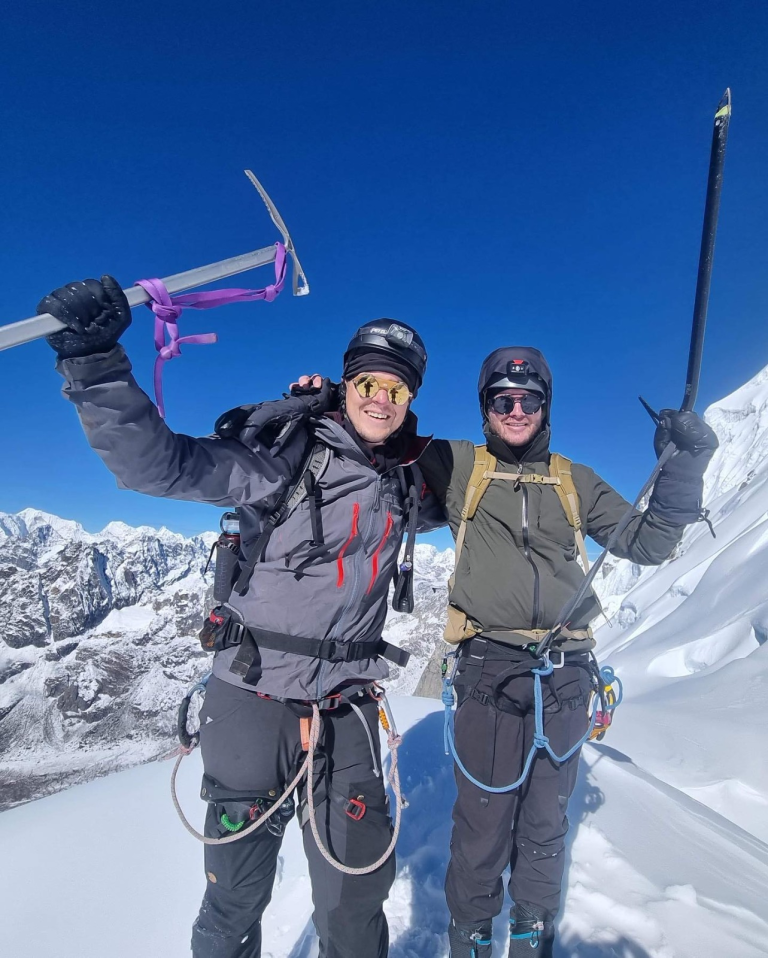Nepal, a land of towering Himalayan giants and remote beauty, offers some of the most exhilarating trekking and mountaineering experiences in the world. Among the numerous climbing options available, Island Peak, Mera Peak, and Lobuche Peak stand out as ideal choices for adventurers seeking a high-altitude challenge with stunning alpine scenery. These peaks not only offer mountaineering thrills but also cultural encounters with Sherpa communities, glacial landscapes, and panoramic views of the world’s highest mountains.
1. Island Peak (Imja Tse)
Elevation: 6,189 meters (20,305 feet)
Location: Khumbu Region, Nepal
Island Peak, locally known as Imja Tse, is one of Nepal’s most popular trekking peaks. Located in the Everest region, it earned its name from Eric Shipton in 1951 because it appears as an island in a sea of ice from Dingboche village.
Why Climb Island Peak?
Island Peak is a perfect introduction to Himalayan mountaineering. The climb involves glacier travel, some technical sections including a steep ice headwall, and a final ridge to the summit. While prior climbing experience helps, it is achievable for fit trekkers with proper acclimatization and basic training.
Scenic Highlights:
Climbers are rewarded with awe-inspiring views of Lhotse (8,516m), Ama Dablam, Makalu, and even Everest from the summit. The journey to Island Peak also takes trekkers through legendary Sherpa villages like Namche Bazaar, Tengboche, and Chhukung.
Best Season to Climb:
Spring (March to May) and autumn (September to November) are ideal for stable weather and clear skies.
2. Mera Peak
Elevation: 6,476 meters (21,247 feet)
Location: Hinku Valley, Makalu-Barun National Park
Mera Peak is the highest trekking peak in Nepal, yet it is considered one of the most straightforward in terms of technical difficulty. Located in the remote Hinku Valley, the peak offers a wild, off-the-beaten-path adventure with less crowded trails compared to the Everest Base Camp region.
Why Climb Mera Peak?
Mera Peak is known for its panoramic summit view, arguably the best in Nepal. On a clear day, climbers can see five of the world’s 8,000-meter peaks: Everest, Lhotse, Cho Oyu, Makalu, and Kangchenjunga. The ascent is mostly non-technical, involving glacier travel and a final steep slope to the summit.
Scenic Highlights:
The trek to Mera Peak begins with a flight to Lukla, followed by a more remote route through rhododendron forests, alpine meadows, and past ancient yak herder settlements. The experience offers both high-altitude adventure and immersion in pristine wilderness.
Best Season to Climb:
Late spring (April-May) and autumn (October-November) are the most suitable times due to favorable weather and visibility
3. Lobuche Peak
Elevation: 6,119 meters (20,075 feet)
Location: Khumbu Region, near Everest Base Camp
Lobuche Peak comes in two main summits:Lobuche Peak (the trekking peak) and Lobuche West (a more technical expedition peak). Most climbers target Lobuche East due to its accessibility and proximity to Everest Base Camp.
Why Climb Lobuche Peak?
Lobuche East offers a more technical climb compared to Island and Mera Peaks. It’s a great choice for trekkers wanting to step up their mountaineering skills. The route involves rock scrambling, fixed ropes, glacier crossings, and steep snow slopes.
What makes Lobuche unique is its combination with the Everest Base Camp trek. Many climbers use the EBC trail for acclimatization before turning towards Lobuche Base Camp, making it a two-in-one Himalayan adventure.
Scenic Highlights:
From the summit, climbers enjoy incredible views of Everest, Nuptse, Lhotse, Pumori, and the Khumbu Glacier. The trail also passes iconic locations like Gorakshep, Kala Patthar, and the famous Tengboche Monastery.
Best Season to Climb:
Spring (March-May) and autumn (September-November) provide the best chance of summit success with minimal weather disturbances.
Comparing the Three Peaks
| Feature | Island Peak | Mera Peak | Lobuche Peak |
| Height | 6,189 m | 6,476 m | 6,119 m |
| Technical Difficulty | Moderate | Low | Moderate-High |
| Best For | First-time climbers with moderate experience | Beginners with good fitness | Climbers seeking a challenge & EBC combo |
| Viewpoints | Lhotse, Makalu, Everest | 5 of the world’s 8000ers | Everest, Nuptse, Pumori |
| Popularity | High | Moderate | Moderate-High |
Preparation and Permits
To climb any of these peaks, climbers must obtain:
- Trekking Permits (such as the Sagarmatha National Park permit or Makalu-Barun permit)
- Peak Climbing Permit issued by the Nepal Mountaineering Association (NMA)
- TIMS Card (Trekkers’ Information Management System)
Most climbs are done with the assistance of registered trekking agencies that provide guides, gear, training, and logistical support.
Final Thoughts
Whether you’re a first-time trekker looking to experience your first Himalayan summit or an experienced climber seeking a technical challenge, Island Peak, Mera Peak, and Lobuche Peak each offer something unique. With proper preparation, acclimatization, and guidance, these mountains provide not only a physical challenge but a deeply rewarding cultural and spiritual journey through the heart of the Nepal Himalayas.
Contact Details
———————
Company address: Everest Trekking Routes Pvt. Ltd.
16 Khumbu, Nayabazaar, Kathmandu, Nepal
Mobile : +977-9843467921 (Rabin)
Email: [email protected]
URL:- www.everesttrekkingroutes.com


